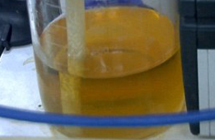正文
“尿液电池”问世:一泡尿可充手机3小时
British scientists have created a new way to charge smartphones - using urine.
英国科学家发明了一种为智能手机充电的新方式——利用尿液。
Researchers have revealed a new system which transforms urine into electricity using a microbial fuel cell.
研究人员表示,这一新系统会通过一个微生物燃料电池,将尿液转换为电力。
Just over half a litre of urine is enough for six hours of charge time, which can power a smartphone for three hours.
只需要半升的尿液,就能够充电六小时,而这能为智能手机提供三个小时的续航时间。
The average toilet break produces around 600ml of urine.
人们平均每次上厕所能产生约600毫升的尿液。

Researchers at the University of the West of England hope the technology will eventually allow people to stay connected when off-grid.
西英格兰大学的研究人员希望,这项技术最终将会使人们能够在断电时,依然保持通信。
Professor Ioannis Ieropoulos, Director of the Bristol Bioenergy Centre, said: 'This project is all about generating electricity from waste material.
布里斯托尔生物能源中心的主任扬尼斯·耶罗普洛斯教授表示:“这项工程致力于将废弃材料转化为电力。
'In other words, turning waste into something really, really useful.
“换句话说,就是将废弃物转变为有用之物。
'And the microbial fuel cell technology is something that does exactly that.
“而微生物燃料电池技术能完成这一转换过程。
It takes the waste that we naturally produce and it converts it directly into electricity.'
“它会将人类产生的排泄物直接转化为电力。”
The fuel cells contain living microorganisms such as those found in soil or the human gut.
燃料电池还包含了那些寄生在土壤中以及人类肠道中的活性微生物。
In breaking down and processing the urine they produce electrons which can then be harnessed into electricity.
在分解和处理尿液时它们会产生电子,而电子可以转变为电力。
The urinal is the result of a partnership between researchers at the University of the West of England in Bristol and Oxfam.
发电马桶是布里斯托尔的西英格兰大学与乐施会(Oxfam)的研究人员们共同合作取得的成果。
It is located near the students' union at the university's Frenchay campus and researchers will be hoping for brisk business at closing time.
它位于西英格兰大学弗朗蔡学院的学生会附近,研究人员也希望项目完成后会带来巨大商机。
Students and staff are being asked to use the urinal to donate pee to fuel the microbial fuel cell stacks that generate electricity to power indoor lighting.
学生以及员工被要求捐献其尿液,为微生物燃料电池提供燃料。而电池产生的电力则用于室内照明。
The urinal on the university campus resembles toilets used in refugee camps by Oxfam to make the trial as realistic as possible.
放在大学校园中的这个发电马桶外形就像乐施会难民营中使用的马桶,目的是让试验环境尽可能接近现实。
The technology that converts the urine in to power sits underneath the urinal and can be viewed through a clear screen.
将发电马桶中的尿液转化为电力的这一技术过程,可直接通过透明隔板观察到。
They hope the abundant, free supply of urine will make the device practical for aid agencies to use in the field.
他们希望大量免费的尿液能为援助机构提供实用的户外设备。
- 上一篇

- 下一篇



 手机网站
手机网站